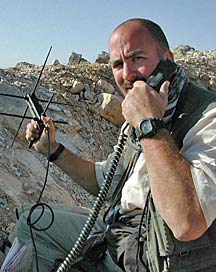Air Force master sergeant
Airman awarded
Silver Star
A Camp Smith NCO wins acclaim
for directing B-52 airstrikes
from horseback in Afghanistan
The Taliban called him "Calvin" and placed a $50,000 bounty on his head.
![]()

![]()
William "Calvin" Markham: Some strikes were just a few hundred feet from his spot
Master Sgt. William "Calvin" Markham, who has been working operations at Camp Smith for the past year, has been in the Air Force for 18 years, 12 as an Air Force combat controller.
Combat controllers operate with Navy SEALs, Army Rangers and Army Special Forces teams to seize airfields and personnel, pinpoint enemy targets, and recover downed pilots and crews in hostile territory.
During the opening moments of the 2001 war in Afghanistan, Markham was the only Air Force member assigned to the Army special-operations team "Triple Nickel," also known as the Army Operational Detachment Team 555.
Earlier this week, Markham, 36, briefed the Hickam Company Grade Officers Council on the close air support missions that used B-52 Stratofortress and B-1 Lancer bombers for the first time to help take enemy guns and equipment pinpointed by spotters on the battlefield.
In a March 17 speech, Air Force Chief of Staff Gen. John Jumper said the military is "taking a completely different look at close air support."
Jumper said it's no longer slow-moving A-10 Thunderbolt and other airplanes close to the ground as was the case in Vietnam. Instead, the bombs were dropped from bombers flying at 50,000 feet.
"What we found in Afghanistan is that the young sergeant -- Sgt. Markham -- on the ground riding a horse with the warlords of Afghanistan as a special operator, who stopped and set up his tripod with his keyboard and his laser goggles and took a sighting on the enemy positions on the next ridge line and beamed them up to the B-52, which then put a string of bombs down that ridge line and took out 200 al-Qaida in one pass and had the warlord tell the young sergeant, 'I've been doing this for 15 years and I've never seen that many of my enemy die at one time in my life,'" Jumper said.
Markham said his Army special-operations team was flown by helicopter from Uzbekistan on Oct. 19 and then taken by horseback to the hills above Bagram.
"We flew below radar, with no armor," Markham said. "The only gear I had was in my backpack."
He estimated his backpack was about 80 pounds, half of which was devoted to weapons and food supplies. "I had a long gun, my M-4 carbine, radio, laser target designator, GPS and night-vision equipment."
In Afghanistan, Markham said he was met with 5,000 to 10,000 Northern Alliance fighters. He was able to call in the first B-52 air strikes in and around Bagram on Oct. 21.
"We were able to take out in the first 30 minutes targets the Northern Alliance had been trying to take out for the past 30 years."
Markham said after a week his team of four special-operations soldiers each had a $50,000 bounty on their heads.
"I was known as Calvin," Markham said. "I heard them on their radio always referring to Calvin."
In his Silver Star citation, which he received July 3, 2003, as a member of the 23rd Special Tactics Squadron, the Air Force credited Markham with directing 175 sorties between Oct. 14 and Nov. 20 that resulted in eliminating 450 enemy vehicles and killing more than 3,500 Taliban fighters.
The Air Force said the air strikes were decisive in supporting the Northern Alliance's ground offensive, which resulted in the liberation of the capital city of Kabul and the surrender of hundreds of al-Qaida and Taliban soldiers.
Markham said during the day his team would spot enemy movements near Bagram and then at night move to a vantage point overlooking the road to Kabul.
"The Taliban would move soldiers and equipment by convoy at night with their headlights on, and we would mark the positions and call down the air strikes. They continued to drive with their headlights on and we continued to call air strikes."
He said at one time there were six four-man special-operations teams in Afghanistan calling in close air support strikes.
Markham recalled one mission in which he was 600 to 1,000 feet away from the front lines of the Taliban when he called down a B-52 bomb strike.
But the bomber didn't have any laser-guided or GPS-guided bombs on board, "just 2,000-pound dumb bombs," Markham said.
"But the pilot was confident that he could place them on target," he added.
He watched as the B-52 flew overhead and estimated that it was six miles north of the target.
"I radioed the pilot and he said that he had to correct for winds ... then he gave me the countdown starting with four minutes and 30 seconds."
Within minutes, the B-52 made its first pass and dropped 14 2,000-pound bombs and then came back and dropped another 14.
The concussion from the bombs was tremendous, scattering debris all over his team. At that point, Markham said he thought, "This is it."
[News] [Business] [Features] [Sports] [Editorial] [Do It Electric!]
[Classified Ads] [Search] [Subscribe] [Info] [Letter to Editor]
[Feedback]
